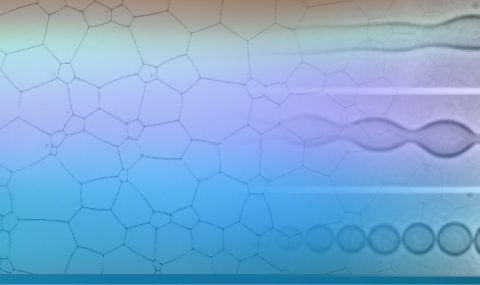Homologous recombination is one of the most fundamental biomolecular processes involving DNA. It plays a key role in the evolution of organisms from bacteria to man, generating genetic diversity by reshuffling genes in eukaryotes, and by enabling the import of new ones in prokaryotes.
Furthermore, it constitutes one of the main pathways for the repair of DNA lesions. During homologous recombination, single-stranded DNA exchanges one of the strands in a DNA duplex, provided enough sequence homology exists between the two, as illustrated:Recombination This process is catalyzed by enzymes called recombinases, such as RecA in bacteria and Rad51 in eukaryotes. We attempt to dissect the elementary steps and mechanisms through which recombination proceeds from a
 \
\
Statistical Mechanics and Molecular Biology viewpoint and its fidelity when the participating sequences are not fully homologous. We seek to elucidate how the search for homology within a huge DNA background takes place, both in vitro using flourescence techniques in ensmble and single-pair modalities, and in vivo.
Fidelity
Our experiments with RecA show that the efficiency of strand exchange can be affected by single base pair differences between the participating strands during the initial stages of the strand exchange process, a fact that is leading to interesting technological applications that we are also pursuing. The single mismatch discrimination cannot be explained by equilibrium statistical mechanical considerations, and we have proposed a cascaded kinetic proofreading scheme to account for it. Using FRET and single-molecule techniques we are studying how RecA assists in the location of particular sequences on bacterial chromosomes.
"High fidelity of RecA-catalyzed recombination: a watchdog of genetic diversity"
D. Sagi, T. Tlusty and J. Stavans, Nucleic Acids. Res. 34, 5021 (2006).
Target location
Homologous recombination is one of the main mechanisms for the generation of genetic diversity from prokaryotes to eukaryotes. Prokaryotes undergoing horizontal gene transfer processes import thousands base pair-long pieces of DNA from the environment, and the latter search the host genome for sites of sufficiently high homology in order to insert themselves. The number of sequences that have to be scanned until homology is found (~107 base pairs) is potentially very large. Yet, the search for homology is bounded by the cell lifetime, imposing severe limits on the time it takes to compare two DNA sequences when they come together in a synaptic complex. In bacteria this implies a ~10-4 sec time per comparison. To test the accuracy of this estimate we have measured the lifetime of individual synaptic complexes as in the scheme below, using total internal reflection fluorescence microscopy. Double-stranded DNA molecules anchored to a surface are tested for homology by fluorescently-labeled, RecA-covered single-stranded molecules, and we study the statistics of synapse lifetimes as function of the sequence differences between the participating molecules. Surprisingly we find that even when the sequences share no homology, the synapse lifetime can be seconds long, and lifetimes increase rapidly with an increase of homology. We are currently carrying out in vivo experiments to learn about the mechanisms behind the search for homology in cells.

“Caught in the act: the lifetime of synaptic intermediates during the search for homology on DNA”
A. Mani, R. Arbel-Goren, I. Braslavsky and J. Stavans, Nucleic Acids Research. 38, 2036 (2010).


